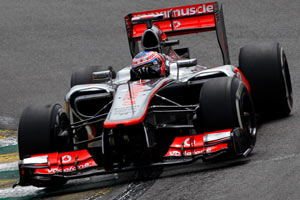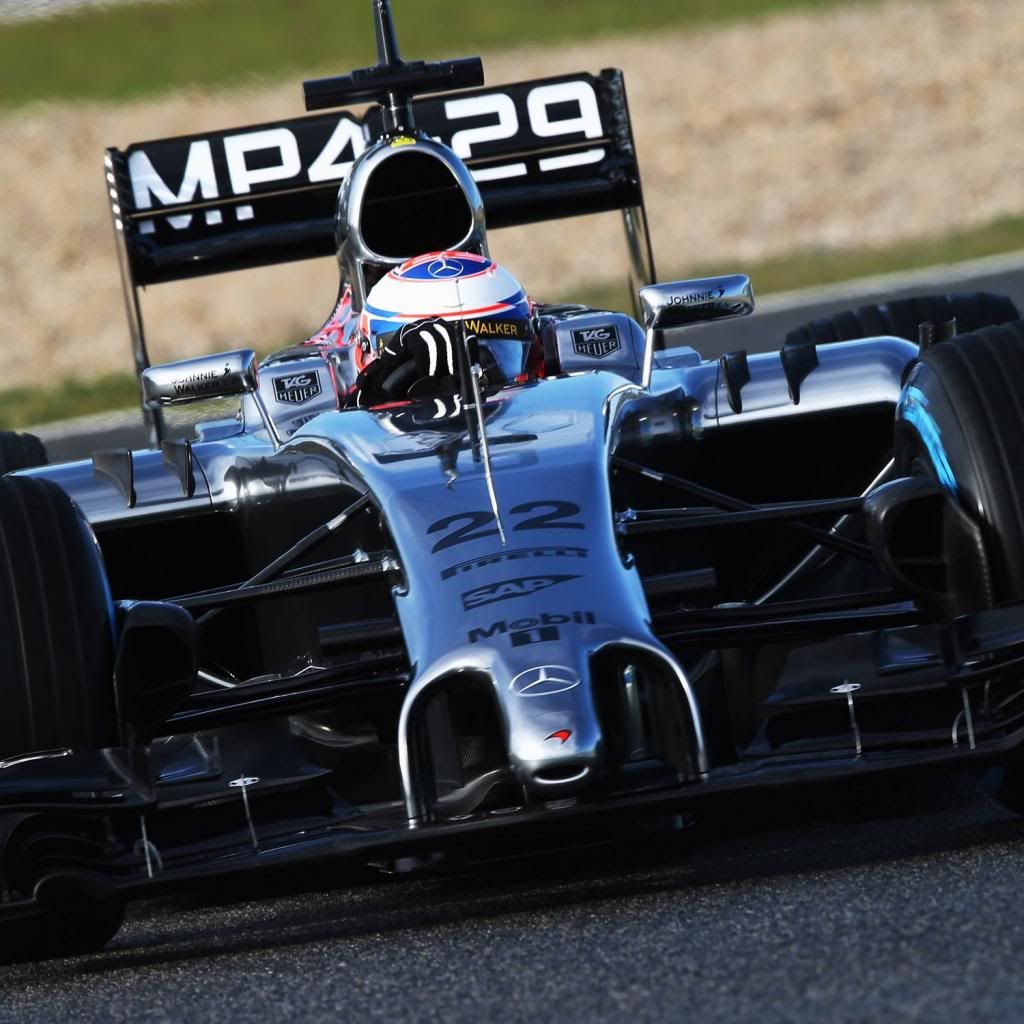The car has been designed to operate within a very small ride-height window to maximise downforce, particularly at high speeds. Rising rate springs are used on the front to keep the car in this narrow window, with very stiff rates towards the end of their range. Into several slow corners this year - notably Bahrain - the McLarens could be seen to be bouncing on the sidewalls of their front tyres, setting up a rocking motion in the whole car as the stiff suspension didn't have the compliance to smother the opposing loads. Other times the problem has manifest itself as a difficulty in switching the front tyres on, in getting them quickly up to the correct operating temperature - as the stiffness in the car minimises the weight transference under braking that would normally aid in generating temperature. Recent rear suspension geometry changes have been to address this issue.
The relentless Silverstone rain of Friday and Saturday rather mixed things up, but even so Hamilton was quickest in the heavy rain of Friday. "We were quick immediately on the full wet tyres," said engineering director Paddy Lowe. "You cannot do that without good downforce." Into qualifying things were still looking ok. When everyone was on full wets, Hamilton was among the very quickest.
But as the rain held off for the crucial Q3 session bringing the track into intermediates territory, a McLaren problem was revealed: it could not get these tyres up to temperature in the one flying lap Hamilton had left after initially opting for wets. His gripless lap was good only for the fourth row, while Fernando Alonso and Mark Webber shared the front row. The Red Bull - with its latest rear body upgrades - was clearly better than Webber had expected through the fast corners and the Ferrari now seems strong on all types of track. But it was impossible to know how the McLaren would have compared in more straightforward circumstances. Was its difficulty on intermediate tyres derived from a set-up issue or was it intrinsic to the car's stiff platform concept? "There are things we can do with tyre pressures which we think will resolve it," said Whitmarsh on Saturday evening.
Poor showing from Hamilton
At that time the forecasts were saying race day would be wet. The car's behaviour on inters was therefore potentially crucial. As it happened, Sunday afternoon was warm and sunny throughout the course of the race but still the McLaren's ultimate pace was difficult to assess. Hamilton's poor grid position ensured he was in a queue forced to circulate at the speed of Michael Schumacher's third-place Mercedes while Alonso and Webber disappeared up front.
But a comparison of Hamilton's speed on his prime tyres - like those used by Alonso to lead throughout his first stint - as the others pitted ahead of him and left him in clear air is illuminating. From laps 14 through to 17 he was consistently lapping in the low-mid 1m 38s, with a best of 1m 38.3s. This was directly comparable with Alonso's pace on the same tyre before he'd pitted - and Lewis' best lap was actually a couple of tenths faster. There are complicating fuel load and tyre deg factors making exact comparison impossible, but as a generality the McLaren's potential pace in that first stint was as good as the race-leading Ferrari's; it's just that its poor starting position had put it in a queue where that couldn't be demonstrated.
Had it qualified in its more usual position - and this was the first time all year Hamilton had not been in the top three fastest qualifiers - there's nothing to suggest it wouldn't have ran at or near the front.
But Hamilton's second and third stints, on option and prime tyres respectively, were not good. "We didn't find the pace we were expecting from the softer tyre," said Lowe, "and in his final stint on the hard Lewis was about 1s per lap slower than he should have been, given what we'd seen on these tyres in the first stint. Lewis said they felt like a completely different type of tyre to those he'd had on in the first stint. The track was hotter than forecast and that seemed to hurt us."
Button reflects on 'tough' race
No-one has yet fully understood the vagaries of this year's tyres, but the McLaren does seem more sensitive than most to changes in conditions - of tyre spec, track temperature and fuel loads. "It was very difficult this weekend keeping the car on that knife edge where it works," Lowe admitted, "and the limited running we were able to do in the practices certainly contributed to that."
Whilst it's true that everyone suffered limited practice running at Silverstone, it's also true that such a limitation would impact more seriously on anyone with a car that is more sensitive to set up, which requires a lot of fine-tuning of a lot of variables to get it in the appropriate set up window.
The Silverstone weather seems to have underlined just how narrow that window is in a car conceived around ultimate aerodynamic performance. The combination of this year's Pirellis with the loss of full-blown diffusers has made the penalty for dropping out of the perfect set of conditions much more severe and seems to have exposed the McLaren - a car that is super-fast when all is right - as particularly sensitive.
Striving for the ultimate at the expense of the averages has also given McLaren the schizophrenic pit-stop performance this year - the fastest times but the biggest number of problems. Is that same philosophy responsible for the car's performance?
- Login or Register
No account yet? Sign up




